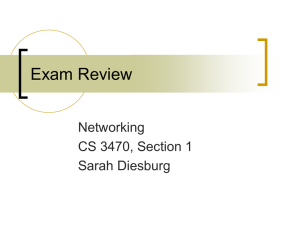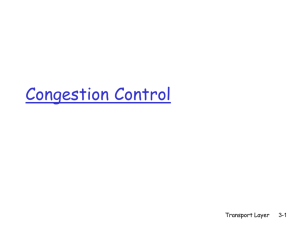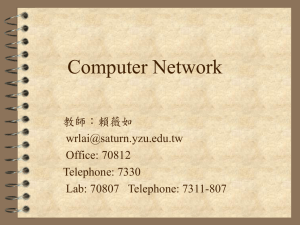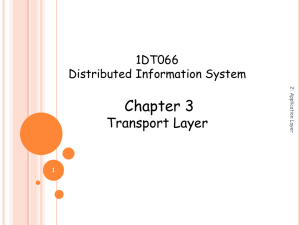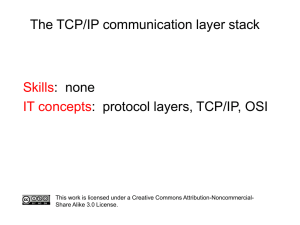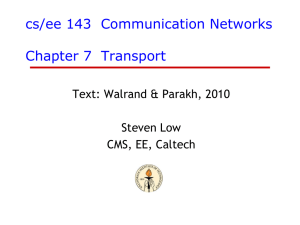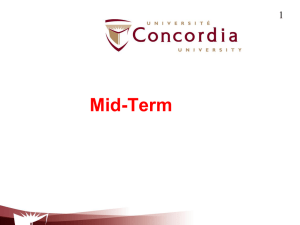Chapter 2: PowerPoint slides - ECE
advertisement
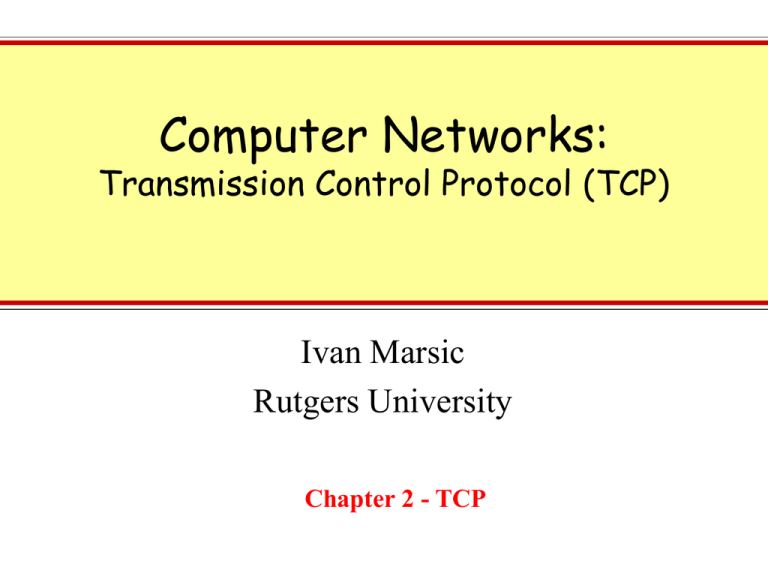
Computer Networks:
Transmission Control Protocol (TCP)
Ivan Marsic
Rutgers University
Chapter 2 - TCP
Transmission Control
Protocol (TCP)
Chapter 2
UDP Header
U D P p a ylo a d
U D P header
0
15 16
1 6 -b it so u rce p o rt n u m b e r
31
1 6 -b it d e stin a tio n p o rt n u m b e r
8
b yte s
1 6 -b it d a ta g ra m le n g th
1 6 -b it d a ta g ra m ch e cksu m
U D P d a ta g ra m d a ta (if a n y)
Topic:
TCP Protocol
TCP Packet (“Segment”) Format
Setting Retransmission Timers
Flow Control
TCP in the Protocol Stack
• End-to-end protocol
• Most popular protocol
in the Internet
(together with IP,
“TCP/IP protocol suite”
L a ye r 3 :
Endto -E n d
L a ye r 2 :
N e tw ork
L a ye r 1 :
L in k
T C P (T ra nsm ission
C o n tro l P roto co l)
Transmission Control Protocol
(TCP)
• Notion of a “session” or “connection”, so
TCP is said to be a connection-oriented
protocol
• TCP “Quality of Service”: Assured
delivery
• Congestion avoidance helps improve
throughput
TCP Session
• Continuous stream of bytes
becomes available for application to use
when a connection is established
and disappears when the connection is closed
Encapsulation of TCP Data
in IP Datagrams
From application: stream of bytes
To application: stream of bytes
Application
Slice into
TCP segments
OSI Layer 4/5: TCP
Concatenate to a byte stream
TCP TCP
hdr payload
TCP TCP
hdr payload
Packetize into
IP packets
OSI Layer 3: IP
Unwrap TCP segments
IP
hdr
TCP
hdr
IP
hdr
TCP
p a ylo a d
Network
Network
TCP
hdr
TCP
p a ylo a d
TCP Header
0
15 16
1 6 -b it so u rce p o rt n u m b e r
31
1 6 -b it d e stin a tio n p o rt n u m b e r
TC P header
3 2 -b it se q u e n ce n u m b e r
4 -b it
header
le n g th
u n u se d
(6 b its)
fla g s
3 2 -b it
a ckn o w le d ge m e n t n u m b e r
U A P R S F
R C S S Y I
G K H T N N
1 6 -b it a d ve rtise d re ce ive w in d o w size
1 6 -b it T C P ch e cksu m
1 6 -b it u rg e n t d a ta p o in te r
T C P p a ylo a d
o p tio n s (if a n y)
T C P se g m e n t d a ta (if a n y)
20
b yte s
Recall the IPv4 Packet Header
0
7 8
4 -b it
ve rsio n
num ber
4 -b it
header
le n g th
15 16
8 -b it d iffe re n tia te d
se rvice s (D S )
1 6 -b it d a ta g ra m le n g th
(in b yte s)
u
n
u D M
s F F
e
d
1 6 -b it d a ta g ra m id e n tifica tio n
8 -b it tim e to live
(T T L )
fla g s
31
8 -b it u se r p ro to co l
1 3 -b it fra gm e n t o ffse t
1 6 -b it h e a d e r ch e cksu m
3 2 -b it so u rce IP a d d re ss
3 2 -b it d e stin a tio n IP a d d re ss
o p tio n s (if a n y)
d a ta
20
b yte s
Urgent Data Pointer
• Last byte of urgent data (LBUD) =
sequenceNumber + urgentPointer
• First byte of urgent data never explicitly
defined
• Any data in Receive buffer up to LBUD may
be considered urgent
R e c e ive d b yte s tre a m , sto re d in R e c e ive B u ffe r
R e c e ive d T C P s e gm e n t
u rg e n t d a ta
n o n -u rg e n t d ata
se q ue nc e n um b e r
s e q . n um + u rg . p tr = L a s t B yte o f U rg e n t D a ta
u rg en t d a ta po inter
Retransmission Timer Calculation
O c c u rre n c e fre q u e n c y
o f m e a s u re d R T T va lu e s
Search the Web for RTT distribution measurement
R T T d istrib u tio n m e a su re d
d u rin g q u ie t p e rio d s
(a)
(b)
1
R T T d istrib u tio n m e a su re d
d u rin g p e a k u sa g e p e rio d s
2
0
0
2
1
M e a s u re d R T T va lu e
TimeoutInterval
C a se s fo r w h ich th e
R T O tim e r w ill e xp ire
to o so o n
(c)
0
M e a su re d R T T va lu e
Retransmission Timer Calculation
Exponential Weighted Moving Average (EWMA)
• Timeout Interval, set as +4 :
TimeoutInterval(t) = EstimatedRTT(t) + 4 DevRTT(t)
• Estimated mean value of RTT:
EstimatedRTT(t) = (1) EstimatedRTT(t 1) + SampleRTT(t)
• Estimated current standard deviation of RTT:
DevRTT(t) = (1) DevRTT(t 1) + SampleRTT(t) EstimatedRTT(t 1)
• The initial value is set as:
DevRTT(0) = 1/2 SampleRTT(0) for the first RTT measurement
• Recommended values of the control parameters are = 0.125 and = 0.25
Retransmission Timer Management
(from Listing 2-1)
•
•
•
•
•
•
•
In method TCPSender.send(), Listing 2-1 // called by the application layer from above
in Line 24:
if (RTO timer not already running) {
set the RTO timer to the current value
as calculated in methods handle() and RTOtimeout();
start the timer;
}
•
•
•
•
•
•
In method TCPSender.handle(), Listing 2-1 // called by IP layer when ACK arrives
in Lines 36 - 38:
if ((lastByteAcked < lastByteSent) {
calculate the new value of the RTO timer using Eq. (2.2);
re-start the RTO timer;
}
•
•
•
•
In method TCPSender.RTOtimeout(), Listing 2-1 // called when RTO timeout
in Line 43:
double the TimeoutInterval; // exponential backoff , Eq. (2.1)
start the timer;
TCP Connection Establishment
Client
Client
Time
SYN_SENT
(active open)
ESTABLISHED
#1
#2
Server
Server
LISTEN
(passive open)
SYN 12275
0000:12275
0000(0)
win 2048, <
mss 1024>
(0)
363371521
:2
1
2
5
1
7
3
3
12>
SYN 236
96, <mss 5
0
4
in
w
,
0
0
0
ack 122750
ack 2363371521
, win 2048
#2
SYN_RCVD
ESTABLISHED
Visit http://en.wikipedia.org/wiki/Network_socket to learn about network sockets
Example TCP Session
CongWin = 1 MSS = 512 bytes
RcvWindow = 4096 bytes
(TCP Sender)
(TCP Receiver)
Client
Client
Server
Server
0:511(512), ac
#3
CongWin = 1 + 1 = 2
k 0, win 2048
ack 512, win 4096
#4
4096
#6
2048:255
9(512), ac
k 0, win 20
48
2560:3071(512)
ack 2048, win 4096
#7
ack 2048, win
3072:3583(512),
ack 0, win 2048
3584
#7
ack 3584, win
4096
#10
#4
512:1023(512
),
#5
1024:1535(512), ack 0,
win 2048
ack 0, win 20
48
ack 1536, win
#6
#7
CongWin = 2 +1+1 = 4
1536:2047(512), ack 0, win 2048
#8
#9
CongWin = 4 +1 = 5
#10
CongWin = 5 +1+1+1 = 8
3584:4
097
#11
(512),
ack 0,
win 20
4096:4607(512)
48
#12
4608:5119(512), ack 0,
win 2048
#10 Gap in sequence!
#10 (buffer 1024 bytes)
3584
ack 3584, win
5120:5631(512), ack 0,
3072
win
3584,
ack
win 2048
#13
#14
Gap in sequence!
(buffer 512 bytes)
Data Transport
(Initial phase: “Slow Start”)
Time
#14
ack 5632, win 4096
CongWin = 8 +1+1+1+1 = 12
detail:
#7
2048:255
9(51
#8
2560:3071(512)
#9
3072:3583(512), ack 0,
win 2048
2), ack 0,
#6
win 2048
ack 2048, win 4096
#7
detail
ack 2048, win
e)
3584 (duplicat
#7
Flow vs. Congestion Control
Flow control
Congestion control
Sender
Sender
Feedback:
“Not much
getting through”
Feedback:
“Receiver
overflowing”
Receiver
Receiver
Topic:
TCP Congestion Control
TCP Tahoe
TCP Reno
TCP NewReno
The Problem
• TCP is a window-based protocol
– Window size represents the amount of resources
available for a communication session
– It limits the number of outstanding
(unacknowledged) packets
• However, unlike a simple ARQ (Chapter 1),
“resources” include both receiver resources and
network resources
• How to know the available network resources?
Network Conceptual Model
Many sources and many receivers …
Network
Network
(a)
We don’t know when sources will start/end their sessions; also their datarates are variable
Simplified Network Model
The entire network is abstracted as a single router – “black box”
RcvWin
CongWin
Receiver resources
Represented by
“Receive Window Size”
(b)
Network resources
Represented by “Congestion Window Size”
TCP Buffer Parameters
[ Sending Application ]
Sent &
acked
Increasing
Allowed to sequence num.
send
[ Receiving Application ]
Delivered to
application
Gap in
recv’d data
Increasing
sequence num.
TCP
receiver’s
byte stream
TCP
sender’s
byte stream
LastByteAcked
LastByteSent
FlightSize
(Buffered in send buffer)
NextByteExpected
LastByteRecvd
Buffered in RcvBuffer
TCP Congestion Control Summary
1. Sender starts with a small window size
2. Send a “burst” of packets (size of the current
sender window) into the network
3. Wait for a feedback about success rate
(acknowledgements from the receiver end)
4. When the (positive/negative) feedback arrives:
a)
b)
+
If the success rate is greater than zero, increase
the sender window size and go to Step 2
– If loss is detected, decrease the sender window
size and go to Step 2
TCP Congestion Control Param’s
Variable
MSS
RcvWindow
CongWindow
LastByteAcked
LastByteSent
FlightSize
EffectiveWindow
SSThresh
Definition
The maximum segment size that the sender can transmit. MSS does not include the TCP/IP
headers and options—only the data payload. This value can be based on the maximum
transmission unit (MTU) of the first link, the path MTU discovery algorithm, or other
factors. By setting MSS to the path MTU, the sender may avoid packet fragmentation
(Section 1.4.1), although this is difficult to achieve because routers change routes
dynamically. [Note that RFC-2581 distinguishes the sender maximum segment size (SMSS)
and the receiver maximum segment size (RMSS).]
The size of the most recently advertised receiver window.
Sender’s current estimate of the available buffer space in the bottleneck router.
The highest sequence number currently acknowledged.
The sequence number of the last byte the sender sent.
The amount of data that the sender has sent, but not yet had acknowledged.
The maximum amount of data that the sender is currently allowed to send. At any given
time, the sender must not send data with a sequence number higher than the sum of the
highest acknowledged sequence number and the minimum of CongWindow and
RcvWindow.
The slow start threshold used by the sender to decide whether to employ the slow-start or
congestion-avoidance algorithm to control data transmission. The slow start algorithm is
used when CongWindow < SSThresh, while the congestion avoidance algorithm is used
when CongWindow > SSThresh. When CongWindow and SSThresh are equal the
sender may use either slow start or congestion avoidance.
TCP Sender State Diagram
TCP Sender
new ACK /
“Send data”
new ACK /
“Send data”
duplicate ACK (less than 3) /
duplicate ACK (less than 3) /
new ACK
& (CongWin SSThresh) /
“Send data”
Start /
Slow Start
Congestion Avoidance
CongWin SSThresh
CongWin SSThresh
for every new ACK, set:
for every new ACK, set:
CongWin CongWin + 1
CongWin CongWin + MSS
MSS
CongWin
timeout /
“Retransmit”
[Reno]
after “fast recovery”
3 duplicate ACKs /
“Retransmit”
(Fast retransmit)
timeout /
“Retransmit”
[Tahoe]
“Send data” 1. Set CongWin & SSThresh
2. Send EfctWin of data, if any
3. Re-start RTO timer
3 duplicate ACKs /
“Retransmit”
(Fast retransmit)
“Retransmit” 1. Set CongWin & SSThresh
2. Re-send oldest outstanding segment
3. Double the RTO timer & re-start it
TCP Receiver State Diagram
Out-of-order segment /
Buffer it & Send dupACK
TCP Receiver
Out-of-order segment /
Buffer it & Send dupACK
Segments arriving in-order
(NextByteExpected = LastByteRecvd + 1)
In-order segment /
Start /
Out-of-order segments
Immediate
acknowledging
In-order seg. /
Send ACK
Delayed
acknowledging
(LastByteRecvd > NextByteExpected)
500 msec elapsed /
Send ACK
In-order segment, completely fills gaps /
Send ACK
In-order segment,
partially fills gaps /
Send ACK
How Much Sender Can Send
• The sender must always ensure that:
LastByteSent
LastByteAcked min{CongWindow, RcvWindow}
• the amount of unacknowledged data should
never exceed:
FlightSize = LastByteSent LastByteAcked
min{CongWindow, RcvWindow}
• TCP session invariant (“allowed to send”):
EffectiveWindow =
min{CongWindow, RcvWindow} FlightSize
How TCP Sender Detects
Segment Loss
• Retransmission timer (RTO) expiration
• Reception of three duplicate ACKs
(four identical ACKs without the arrival of any
other intervening packets)
Why three dupACKs:
– If there is just a reordering of the segments, there will be
only one or two dupACKs before the reordered segment
is processed, which will then generate a regular ACK.
– If three or more dupACKs are received in a row, it is a
strong indication that a segment has been lost.
How TCP Sender Detects
Segment Loss
TCP
Event
TCP Sender’s Action
Version
Tahoe
Set CongWindow = 1MSS
Timeout
Reno
Tahoe
Set CongWindow = 1MSS
Reno
Set CongWindow =
max {½ FlightSize, 2MSS} + 3MSS
3dup
ACKs
Slow Start Threshold
• Determines when the “slow start” phase ends
and the “congestion avoidance” phase begins
• SSThresh = max {½ FlightSize, 2MSS}
TCP Tahoe Sender
(Effective Window computed as before …)
When packet loss detected via 3 dupACKs:
SSThresh(t) = max {½ CongWindow(t1), 2MSS}
(2.4)
Congestion Window computation
under Congestion Avoidance:
CongWin ( t ) CongWin ( t 1) MSS
MSS
CongWin ( t 1)
[bytes]
(2.5)
TCP-Tahoe Sender State Diagram
new ACK & (CongWin SSThresh) /
“Send data”
Tahoe Sender
Start /
new ACK /
“Send data”
dupACKs
count = 0
Slow Start
Congestion Avoidance
dupACK /
dupACK /
new ACK /
“Send data”
0 dupACKs
count 3
dupACK /
new ACK /
“Send data”
dupACK /
dupACKs
count = 0
new ACK /
“Send data”
0 dupACKs
count 3
Fast retransmit
dupACK & (count 3) /
“Retransmit”
timeout /
“Retransmit”
“Send data” 1. Set CongWin & SSThresh
2. Send EfctWin of data, if any
3. Re-start RTO timer
timeout /
“Retransmit”
Fast retransmit
dupACK & (count 3) /
“Retransmit”
“Retransmit” 1. Set CongWin & SSThresh
2. Re-send oldest outstanding segment
3. Double the RTO timer & re-start it
TCP-Reno Sender State Diagram
dupACK /
CongWin CongWin + 1 & “Send data”
Fast Recovery
Reno Sender
Fast retransmit
dupACK & (count 3) /
“Retransmit”
On entry, set:
SSThresh ½ CongWin
CongWin SSThresh + 3MSS
& “Send data”
timeout /
“Retransmit”
new ACK /
“Send data”
dupACK /
recovery ACK /
CongWin SSThresh
& “Send data”
dupACK /
Congestion Avoidance
0 dupACKs
count 3
dupACKs
count = 0
new ACK /
“Send data”
timeout /
“Retransmit”
dupACK /
timeout /
“Retransmit”
new ACK & (CongWin SSThresh) /
“Send data”
dupACKs
count = 0
new ACK /
“Send data”
new ACK /
“Send data”
Fast retransmit
dupACK & (count 3) /
“Retransmit”
Slow Start
Start /
0 dupACKs
count 3
dupACK /
Example 2.1: TCP Bottleneck Link
10 Mbps
Router
1 Mbps
Sender
Receiver
6+1 packets
Router Architecture
CPU
Memory
I/O Transmit/Receive
6 slots for packets
1 packet in transmission
Detail of Transmission Round #5
Sender
Time = 4 RTT
Receiver
6 packets buffered:
#16
FlightSize
Dropped
packets
#14 #15
Transmission time on link_2
equals 10 (Tx time on link_1)
LastByteRecvd NextByteExpected
22 21 20 19 18 17
#14 #15
LastByteAcked
Segments #16
transmitted: #17
#18
#19
#20
#21
#22
#23
#24
#25
#26
#27
#28
#29
Router
#29 #30
LastByteSent
#17
Segment #16
received
27 22 21 20 19 18
Time
packet #27 occupies the
slot emptied by packet #17
#18
Segment #17
received
Sender
Sender
CongWin = 1 MSS
EfctWin = 1
Receiver
Receiver
#1
1 RTT
seg 1
ack 2
CongWin = 1 + 1
#2
1024 bytes
to application
#4
2 KB
to appl
#2,3
EfctWin = 2
2 RTT
CongWin = 2 +1+1
#4,5,6,7
EfctWin = 4
4 KB
to appl
#8
3 RTT
CongWin = 4 +1+1+1+1
EfctWin = 8
#8,9, …,14,15
4 RTT
8 segments sent
seg 15
(loss)
ack 15
#15
7 KB
to appl
[ 1 segment lost ]
CongWin = 8 +1+…+1
EfctWin = 14
#16,17, …,22,
23,…,27,28,29
7
Gap in sequence!
(buffer 7 KB)
[ segment #15 missing ]
14 segments sent
k 15
7 d u p ac
#15,15,…,15
seg 27
5 RTT
7+1 dupACKs
CongWin = 1
#15
6 RTT
CongWin = 1 + 1
EfctWin = 0
CongWin = 1
EfctWin = 1
CongWin = 1 + 1
EfctWin = 0
#15
dup ack 15
(buffer 8 KB)
[ 5 segments missing ]
seg 15 (retransmission)
#23
ack 23
8 KB
to appl
[ 4 segments missing ]
[ segment #27 buffered ]
7 RTT
8 RTT
RTO timeout
9 RTT
Time [RTT]
#23
seg 23 (retransmission)
ack 24
#24
1024 bytes
to appl
[ 3 segments missing ]
[ segment #27 buffered ]
RTO Timer Timeout Pattern
6 RTT
ack 23
icon indicates when
RTO timer is started
7 RTT
8 RTT
RTO t-out
9 RTT
seg 23 (retransmission
)
16 RTT
ack 24
17 RTT
10 RTT
18 RTT
11 RTT
19 RTT
12 RTT
20 RTT
13 RTT
RTO t-out
14 RTT
15 RTT
seg 24 (retransmission
)
21 RTT
ack 25
22 RTT
RTO t-out
23 RTT
24 RTT
seg 25 (retransmission
ack 26
)
TCP Tahoe (2)
MSS = 1024 bytes, RcvWindow = 64 KB
EffctWin
[bytes]
65535
CongWin
FlightSize
EffctWin
SSThresh
[MSS]
15MSS
14336
14
8192
8
4096
4
6 3 dupACKs
9 RTO timeout
2MSS
2
1
Time
#79,80,81,82,83
#75,76,77,78
#73,74
#65
#66,67,68, …,72
#58,59,60, …,64,65
#51,52,53, …,57
#40,41,42,43,44
#45,46,47,48,49, 50
140 142 144 146 148 150 [RTT]
139 141 143 145 147 149
#36,37,38,39
138
#33,34,35
137
#31,32
8 9 10 11
#29
7
#23
#15
#16,17, …,22,23,…,29
4 5 6
#8,9, …,14,15
2 3
#4,5,6,7
1
#2,3
1MSS
#1
Segments sent
2048
1024
TCP Tahoe (3)
Multiplicative decrease
TCP Tahoe: CongWin 1 MSS
TCP Reno: CongWin 1/2 FlightSize
15
Slow start
When CongWin SSThresh, for each ACK:
CongWin(t) CongWin(t–1) + MSS2 / CongWin(t–1)
For each ACK:
CongWin CongWin + 1
CongWin [MSS]
Additive increase
(Congestion avoidance)
8
Retransmit based on RTO timeout
(“slow retransmit”)
4
SSThresh
2
1
0
1
2
3
4
5
6
7
8
9 10 11
21 22 23 24 25 26 27 28 29 30 31 32 33 34 35 36 37 38 39
Fast retransmit
Retransmit oldest un-acknowledged segment
after 3 dupACKs without waiting for RTO timeout
Time [RTT]
TCP Sender States / Phases
Slow Start:
Defined by: Congestion Window (CW) SSThresh
Congestion Window calculation:
CW(t) = CW(t – 1) + #ACKMSS
Fast Retransmit:
Defined as:
When 3 dupACKs received,
retransmit the oldest outstanding packet without waiting for RTO timeout
Congestion Avoidance:
Defined by: Congestion Window (CW) > SSThresh
Congestion Window calculation:
#ACKMSS
CW(t) = CW(t – 1) + MSS
CW(t – 1)
Reno-Specific State / Phase
Same as for Tahoe:
Slow Start, Fast Retransmit, Congestion Avoidance
Fast Recovery:
Defined as:
When 3 dupACKs received,
Congestion Window calculation:
CW(t) = max {½ FlightSize(t), 2MSS} + 3MSS
( Unlike TCP Tahoe sender,
which sets CW(t) = 1MSS
when 3 dupACKs received )
TCP Reno Sender
(Effective Window computed as before …)
When packet loss detected via 3 dupACKs:
SSThresh(t) = max {½ FlightSize(t1), 2MSS}
(2.6)
CongWindow(t) = SSThresh(t) + 3MSS
(2.7)
Enter Fast Recovery: count each “old ACK” as +MSS
to CongWin.
When “new ACK” received, exit Fast Recovery
and enter Congestion Avoidance.
CongWindow = SSThresh
(2.8)
65535
[bytes]
[MSS]
16384
15
8
15
2
1
4096
4
2048
1024
2
1
24
0 1 2 3 4 5 6 7 8 9 10 11
18 19 20 21 22 23 24 25 26 27 28 29 30 31 32 33 34 35 36 [RTT]
6 dupACKs
7+1 dupACKs
3 dupACKs
#29
#53,54,55,56
#36,57
#58
#59 (1 byte)
#37
#60,61, …,66
#67,68, …,73,74
#75,76, …,81
#74,82,83
#84,85,…,90,91,…,94,95
EffctWin
#28
#50 (1 byte)
#51 (1 byte)
#52 (1 byte)
8
#26
#47 (1 byte)
#48 (1 byte)
#49 (1 byte)
8192
#1
#2,3
#4,5,6,7
#8,9, …,14,15
#16,17, …,22,23,…,29
#15,30,…,35,36,37
#23
#38 (1 byte)
#39 (1 byte)
#40 (1 byte)
#24
#41 (1 byte)
Segments sent
TCP Reno (1)
SSThresh
CongWin
73
28
29
59
66
4
36
37
23
EffctWin
FlightSize
Time
4 dupACKs
7 dupACKs
TCP Reno (2)
SSeennddeerr
C o n gW in = 6 . 7 M S S
E fc tW in = 0
C o n gW in =
# 5 2 (1 b yte )
26 R TT
3 dupACKs
3 1 6 . 3
6 . 7
2
E fc tW in = 1
R
Reecceeive
iverr
#29
seg 29
#36
ack 36
# 5 3 ,5 4 ,5 5 ,5 6
E fc tW in = 4
28 R TT
C o n gW in = 6 . 3 1
4 dupACKs
29 R TT
seg 36
#58
30 R TT
C o n gW in = 7 . 3
7 . 3
2
1 0 2 4 b yte s
to a p p l
(b u ffe r 1 0 2 4 b yte s )
seg 58
#37
(b u ffe r 1 K B )
#37
(b u ffe r 1 b yte )
ack 37
# 5 9 (1 b yte )
s e g 5 9 (1 b yte )
E fc tW in = 0
31 R TT
#37
#37
ack 37
E fc tW in = 1
3 dupACKs
3 6 . 6
ack 37
#37
seg 37
E fc tW in = 1
32 R TT
ack 60
C o n gW in = 7 . 6
E fc tW in = 7
# 3 6 ,3 6 ,3 6 ,3 6
ack 36
ack 37
C o n gW in = 7 . 3
7 1 6 8 b yte s
to a p p lic a tio n
G a p in s e q u e n c e!
(b u ffe r 4 K B )
# 3 6 ,5 7
E fc tW in = 2
C o n gW in =
# 2 9 (b u ffe r 1 b yte )
ack 29
27 R TT
C o n gW in = 6 . 3
s e g 5 2 (1 b yte )
# 6 0 ,6 1 , … ,6 6
T im e [R T T ]
#60
1024 + 16 + 6144
b yte s to a p p lic a tio n
Topic:
TCP NewReno Protocol
Partial ACKs for Pkt Loss Detection
Example
How TCP Sender Discovers Packet Loss
• Retransmission timer (RTO) expired
• 3 dupACKs received
• Partial ACK received
TCP Tahoe
&
TCP Reno
TCP NewReno
TCP NewReno – Partial ACKs
• Defined at the time tloss when the sender
discovers a packet loss (by 3 dupACKs):
• Full acknowledgment: If the sender will
receive an ACK for all packets that were
outstanding at the time tloss
• Partial acknowledgment: If the sender will
receive an ACK for some of the packets that
were outstanding at the time tloss
TCP NewReno
TCP Sender
TCP Receiver
EffectiveWindow
#1
#2
#3
#4
#5
NextByteExpected =
LastByteRecvd + 1
#6
LastByteRecvd
LastByteAcked =
LastByteSent
Receive buffer
(loss)
(loss)
(loss)
Time
#2
tloss
#6
NextByteExpected
FlightSize
LastByteAcked
#4
LastByteRecvd
te)
te)
te)
lica
p
lica
u
lica
p
d
p
(
u
u
(d
(d
k#1
k#1
Ac
k #1
Ac
Ac
LastByteSent
LOSS DETECTED
(3 dupACKs)
At this time define:
Full acknowledgment =
ACK for all 6 outstanding pkts
LOSS DETECTED
(partial ACK)
Seg#1 (retransmission
)
#1
#2
#4
LastByteRecvd
Ack#3 (partial)
NextByteExpected
Seg#3 (retransmission
)
#6
TCP NewReno Fast Recovery
• NewReno sender enters Fast Recovery when
a loss is detected (by 3 dupACKs)
• NewReno sender exits Fast Recovery when
it receives the full acknowledgement
(defined at time tloss)
• After Fast Recovery, NewReno sender enters
Congestion Avoidance
Congestion Window Calculation
during Fast Recovery
• NewlyAcked =
LastByteAcked(t) LastByteAcked(t 1)
• If (NewlyAcked < MSS), then
CongWindow(t) =
CongWindow(t 1) NewlyAcked
• Else if (NewlyAcked MSS), then
CongWindow(t) =
CongWindow(t 1) NewlyAcked + MSS
TCP NewReno: Example (1)
Example 2.2
Link 1
Sender
4+1 packets
Router
txmit (Link 1) << txmit (Link 2)
tprop (Link 1) << tprop (Link 2)
tprop (Link 2) = 6 txmit (Link 2)
Link 2
Receiver
TCP NewReno: Example (2)
Example 2.2
Sender
txmit(Link 1)
transmission on Link 1
propagation on Link 1
tprop(Link 1)
Sender/Router
0
1
transmission on Link 2
2 3
pkt
Router
propagation on Link 2
10
ack
txmit(Link 2)
Receiver
Sender/Router
0
txmit(Link 1)
1
tprop(Link 1)
pkt
Receiver
txmit(Link 2)
10
2 3
ack
Sender/Router
0
1
10
20
2 3
pkt
4 5 6 7
Time [in packet transmission slots]
30
3 dupACK
40
50
60
8 9 10 11 12 13 14 15 16 171819202122242628
30323436 3840 42 44 23
17
25 46
ack
Receiver
Congestion window [segments]
SSThresh = 65535 bytes
20
SSThresh = 11 MSS
10
CongWin
Lost packets:
23, 25, 27, 29, 31, 33, 35, 37, 39, 41, 43, 45 (12 total)
0
Packets in Router buffer
Slow Start
5
0
3
2 3
1
Fast Retransmit Fast Recovery
7
5 6 7
4 5 6 7
15
21 22 24 26 28 30 32 34 36 38 40 42 44
13 14 15
19 20 21 22 24 26 28 30 32 34 36 38 40 42 44
11 12 13 14 15 17 18 19 20 21 22 24 26 28 30 32 34 36 38 40 42 44 23
9 10 11 12 13 14 15 16 17 18 19 20 21 22 24 26 28 30 32 34 36 38 40 42 44 23
8 9 10 11 12 13 14 15 16 17 18 19 20 21 22 24 26 28 30 32 34 36 38 40 42 4423
7
6 6
5 5 5
3 4 4 4 4
13 14 15 16 17 18 19 20 21 22 24 26 28 30 32 34 36 38 40 42 44
12 12 13 14 15 16 17 18 19 20 21 22 24 26 28 30 32 34 36 38 40 42 44 23
11 11 11 12 13 14 15 16 17 18 19 20 21 22 24 26 28 30 32 34 36 38 40 42 44 23
7 8 9 10 10 10 10 11 12 13 14 15 16 17 18 19 20 21 22 24 26 28 30 32 34 36 38 40 42 44 23
6 7 8 9 9 9 9 10 11 12 13 14 15 16 17 18 19 20 21 22 24 26 28 30 32 34 36 38 40 42 44 23
5 6 7 8 8 8 8 9 10 11 12 13 14 15 16 17 18 19 20 21 22 24 26 28 30 32 34 36 38 40 42 4423
46
2546
Packets in flight on 2nd link
6
0
1
3
2 2
46
25 25
Sender/Router
60
27 47 48
ack
70
29 49 50 51
80
31 52 53 54 55
Time [in packet transmission slots]
90
33 56 57 58 59 60
100
110
120
35 61 62 63 64 65 66 37 67 68 69 70 71 72 73 39 74 75 76 77 78 79 80 81 41 82 83 84 85 86 87
pkt
Receiver
CW = 51
Congestion window [segments]
40
Fast Recovery (cont’d)
30
CongWin
SSThresh = 11 MSS
20
Congestion Avoidance
Packets in Router buffer
5
0
47 48
27 4748
49 50 51
29 49 50 51
82 83 84 85 86 87 88 89 90
74 75 76 77 78 79 80 81 41 82 83 84 85 86 87 88 89
61 62 63 64 65 66 67 68 69 70 71 72 73 39 74 75 76 77 78 79 80 81 41 82 83 84 85 86 87 88
35 61 62 63 64 6566 37 67 68 69 70 71 72 73 39 74 75 76 77 78 79 80 81 41 82 83 84 85 86 87
52 53 54 55
31 52 53 5455
5657 58 59 60
3356 57 58 5960
55
54 54
51 31 52 53 53 53
50 51 31 52 52 52
49 50 51 31 31 31
60
65 66 37 67 68 69 70 71 72 73 39 74 75 76 77 78 79 80 81 41 82 83 84 85 86
59 59 60 35 61 62 63 64 64 65 66 37 67 68 69 70 71 72 73 39 74 75 76 77 78 79 80 81 41 82 83 84 85
55 33 56 57 58 58 58 59 60 35 61 62 63 63 64 65 66 37 67 68 69 70 71 72 73 39 74 75 76 77 78 79 80 81 41 82 83 84
54 55 33 56 57 57 57 58 59 60 35 61 62 62 63 64 65 66 37 67 68 69 70 71 72 73 39 74 75 76 77 78 79 80 81 41 82 83
53 54 55 33 56 56 56 57 58 59 60 35 61 61 62 63 64 65 66 66 67 68 69 70 71 72 73 39 74 75 76 77 78 79 80 81 41 82
52 53 54 55 33 33 33 56 57 58 59 60 35 35 61 62 63 64 65 37 66 67 68 69 70 71 72 73 39 74 75 76 77 78 79 80 81 41
Packets in flight on 2nd link
6
48
46
47 47
0 2546 27 27 27
51
50 50
48 29 49 49 49
47 48 29 29 29
Topic:
TCP Over Wireless
Reducing Link-Layer Overheads
TCP Over Wireless
• Slow start until reaches the SSThresh size;
set timer for every burst
• If no ACK congestion;
halve the window size; slow start again
Wireless Link-layer Overhead
TCP layer:
TCP data segment
[1024 KB + 40 bytes headers]
TCP ACK segment
[0 KB + 40 bytes headers]
Link layer:
Link layer overhead: backoff delay, interframe spaces, link-layer control frames (RTS, CTS, ACK)

